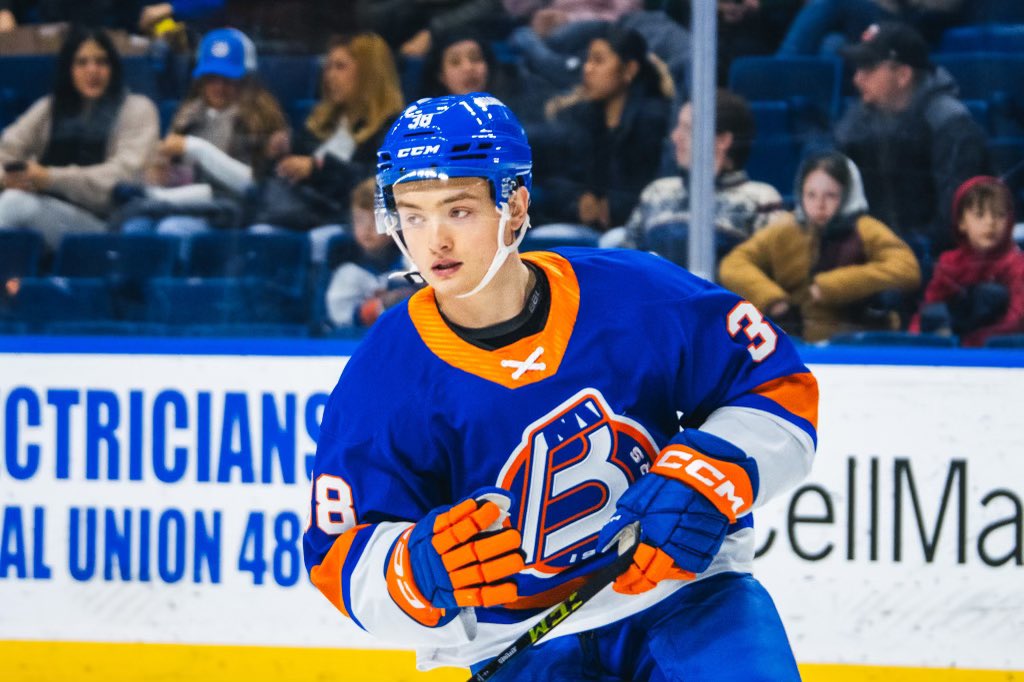Alex Jefferies is a 6-foot, 194-pound right-shot winger who was drafted 121st by the New York Islanders in the 2020 NHL Draft. He is 22 years old and has spent the past four seasons with Merrimack College of the National Collegiate Athletics Association (NCAA). In 105 NCAA games, he scored 43 goals and 107 points, leading to a Hobey Baker Award nomination his senior season. After concluding his senior season with Merrimack this season, he signed an amateur tryout with the Bridgeport Islanders. In 12 games with the disappointing Bridgeport Islanders, he scored three goals and seven points. On April 19 he signed a two-year, entry-level contract with the Islanders that begins in the 2024-25 season.
Related: Every NHL Team’s Most Underrated Prospect
He spent the majority of his college career on the left wing but played right wing for Bridgeport, at times alongside Carsen Twarynski and Brian Pinho. Bridgeport had one of the worst forward cores this past season, but Jefferies’ ability to step in and make an immediate impact is a cause for recognition, and his ability to play both sides of the ice will pay dividends in the future.
Strengths
Jefferies’ game has a lot of strengths. He plays a great two-way game, positioning himself well on the backcheck and defending like an NHL veteran. He looks like a professional in all aspects of the game, and he lifts his linemates’ performance by making the crisper passes and getting to the puck that split-second faster than most. While the defense is not the focal point of many college player’s careers, Jefferies’ defensive abilities should not go unnoticed.
Jefferies’ main strength is his professional play style. While he is strong defensively, his offensive game is well-rounded, with his vision and passing leading his offensive game. He makes great reads and seems to have eyes on the back of his head. He knows where his teammates are, and finds ways to get the puck close to the net. This has been especially prevalent during his time in Bridgeport, where he has continuously made great reads but the puck jumps a player’s stick or a shot is missed.

Jeffries is also not afraid to get near the goal utilizing his strong wrist shot. His 43 NCAA goals did not mostly come from snipes, but rather from getting close to the net, fighting for rebounds, and getting to the open ice. He does not fit into a playmaker or power forward mold, but he is a well-rounded winger who can make plays few else can.
Concerns
The reality with Jefferies is there are not many concerns. He does not struggle in any one aspect of the game, and he has improved each year since being drafted. The one area of his game that seeks the most improvement would be his skating. He has solid speed, but he is not so fast moving side to side. If he seeks to play well in the NHL, he will need to improve his edgework to take his game to the next level. In addition, he should continue to develop all aspects of his game, picking up on the small differences between the professional and collegiate levels.
Other Islanders Prospect Profiles
Estimated Time of Arrival
Predicting the time of arrival for Islanders’ players in the Lou Lamoriello era is a difficult task. Much of the forward core remains season to season and the team is contending, so making room for an unproven 22-year-old is hard to imagine. The reality is Jefferies is close to NHL-ready and could be in the NHL at some point during the 2024-25 season.
He could slot in as a winger to replace anyone in the lineup, but his best fit could be on the second line alongside Brock Nelson and Kyle Palmieri. The two have not had a definitive third linemate with Pierre Engvall’s struggles this season and Anders Lee playing just the final stretch of the season. Jefferies could play the left wing and provide defensive responsibility while keeping up with the offense. Engvall often looked a step ahead or behind on the line, so if Jefferies could find his groove, he would become a mainstay in the lineup.
Ceiling and Floor
Jefferies does not dominate at any one aspect of the game, leaving his ceiling lower than most prospects. A realistic ceiling would be longtime Islander Josh Bailey’s late 2010s performances. Bailey was consistently near the 20-goal mark, putting up around a 50-60 point pace as a two-way winger playing throughout the top-nine. He was never the star of the team, but he kept up with the stars, both as a linemate and an opposing winger.

Jefferies’ floor is not making the NHL. He has played just a few weeks at the professional level, and with the Islanders clogged at wing in the NHL, he may never get his chance. More realistically, however, is he gets to the NHL in a few seasons and bounces around the bottom six, playing a similar role to Simon Holmstrom this season. His ability to play left wing will reward him in the Islanders’ organization, but the franchise’s inability to develop youth forwards could hinder his development.
Jefferies’ most likely NHL projection is to be Josh Bailey, but closer to his 2013-14 and 2014-15 seasons where he would score around 10-12 goals and 30-40 points in the middle six while also playing penalty kill and occasionally powerplay. He will provide stability, consistency, and predictability to the Islanders’ forward core, a trait not apparent in a few too many of the current forwards.
As the offseason continues, Jefferies is well-positioned to put in a lot of hard work to fight for an NHL roster spot out of training camp. He is an exciting prospect who has driven up the Islanders’ prospect pool and is a player fans should view as a future NHL winger.